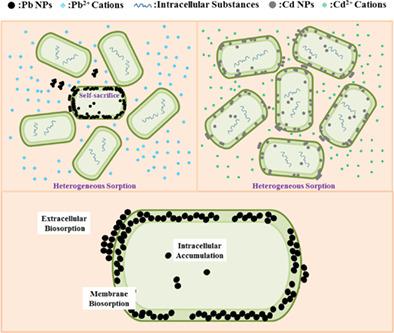当前位置:
X-MOL 学术
›
Environ. Microbiol.
›
论文详情
Our official English website, www.x-mol.net, welcomes your feedback! (Note: you will need to create a separate account there.)
Contrasting the Pb (II) and Cd (II) tolerance of Enterobacter sp. via its cellular stress responses
Environmental Microbiology ( IF 5.1 ) Pub Date : 2019-07-02 , DOI: 10.1111/1462-2920.14719 Zhongquan Jiang 1 , Liu Jiang 1 , Lin Zhang 1, 2 , Mu Su 1 , Da Tian 1 , Tong Wang 1 , Yalin Sun 1 , Ying Nong 1 , Shuijin Hu 1, 3 , Shimei Wang 1, 2 , Zhen Li 1, 2
Environmental Microbiology ( IF 5.1 ) Pub Date : 2019-07-02 , DOI: 10.1111/1462-2920.14719 Zhongquan Jiang 1 , Liu Jiang 1 , Lin Zhang 1, 2 , Mu Su 1 , Da Tian 1 , Tong Wang 1 , Yalin Sun 1 , Ying Nong 1 , Shuijin Hu 1, 3 , Shimei Wang 1, 2 , Zhen Li 1, 2
Affiliation

|
Successful application of microorganisms to heavy metal remediation depends on their resistance to toxic metals. This study contrasted the differences of tolerant mechanisms between Pb2+ and Cd2+ in Enterobacter sp. Microbial respiration and production of formic acid showed that Enterobacter sp. had a higher tolerant concentration of Pb (>1000 mg l−1) than Cd (about 200 mg l−1). Additionally, SEM confirmed that most of Pb and Cd nanoparticles (NPs) were adsorbed onto cell membrane. The Cd stress, even at low concentration (50 mg l−1), significantly enlarged the sizes of cells. The cellular size raised from 0.4 × 1.0 to 0.9 × 1.6 μm on average, inducing a platelet‐like shape. In contrast, Pb cations did not stimulate such enlargement even up to 1000 mg l−1. Moreover, Cd NPs were adsorbed homogeneously by almost all the bacterial cells under TEM. However, only a few cells work as ‘hot spots’ on the sorption of Pb NPs. The heterogeneous sorption might result from a ‘self‐sacrifice’ mechanism, i.e., some cells at a special life stage contributed mostly to Pb sorption. This mechanism, together with the lower mobility of Pb cations, caused higher microbial tolerance and removal efficiency towards Pb2+. This study sheds evident contrasts of bacterial resistance to the two most common heavy metals.
中文翻译:

对比肠杆菌的Pb(II)和Cd(II)耐受性。通过其细胞应激反应
微生物在重金属修复中的成功应用取决于它们对有毒金属的抵抗力。这项研究对比的容错机制铅之间的差别2+和Cd 2+的肠杆菌属。微生物的呼吸作用和甲酸的产生表明肠杆菌属。铅的耐受浓度(> 1000 mg l -1)高于镉(约200 mg l -1)。此外,SEM证实大多数Pb和Cd纳米颗粒(NPs)都吸附在细胞膜上。即使在低浓度(50 mg l -1),大大扩大了细胞的大小。细胞大小平均从0.4×1.0增加到0.9×1.6μm,形成血小板样形状。相反,Pb阳离子甚至在高达1000 mg l -1时也不会刺激这种增大。而且,Cd NPs在TEM下几乎被所有细菌细胞均一地吸附。但是,只有少数细胞充当Pb NPs吸附的“热点”。异质吸附可能是由于“自我牺牲”机制引起的,即某些处于特殊生命阶段的细胞主要是对Pb吸附的贡献。这种机制,加上较低的Pb阳离子迁移率,导致较高的微生物耐受性和对Pb 2+的去除效率。这项研究揭示了细菌对两种最常见的重金属的抵抗力的明显对比。
更新日期:2020-04-01
中文翻译:

对比肠杆菌的Pb(II)和Cd(II)耐受性。通过其细胞应激反应
微生物在重金属修复中的成功应用取决于它们对有毒金属的抵抗力。这项研究对比的容错机制铅之间的差别2+和Cd 2+的肠杆菌属。微生物的呼吸作用和甲酸的产生表明肠杆菌属。铅的耐受浓度(> 1000 mg l -1)高于镉(约200 mg l -1)。此外,SEM证实大多数Pb和Cd纳米颗粒(NPs)都吸附在细胞膜上。即使在低浓度(50 mg l -1),大大扩大了细胞的大小。细胞大小平均从0.4×1.0增加到0.9×1.6μm,形成血小板样形状。相反,Pb阳离子甚至在高达1000 mg l -1时也不会刺激这种增大。而且,Cd NPs在TEM下几乎被所有细菌细胞均一地吸附。但是,只有少数细胞充当Pb NPs吸附的“热点”。异质吸附可能是由于“自我牺牲”机制引起的,即某些处于特殊生命阶段的细胞主要是对Pb吸附的贡献。这种机制,加上较低的Pb阳离子迁移率,导致较高的微生物耐受性和对Pb 2+的去除效率。这项研究揭示了细菌对两种最常见的重金属的抵抗力的明显对比。



























 京公网安备 11010802027423号
京公网安备 11010802027423号